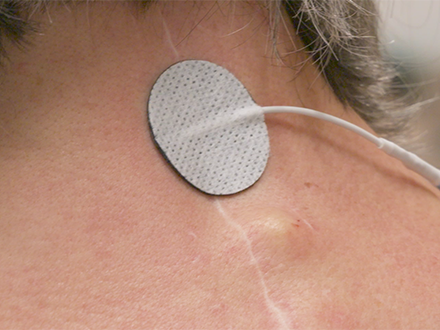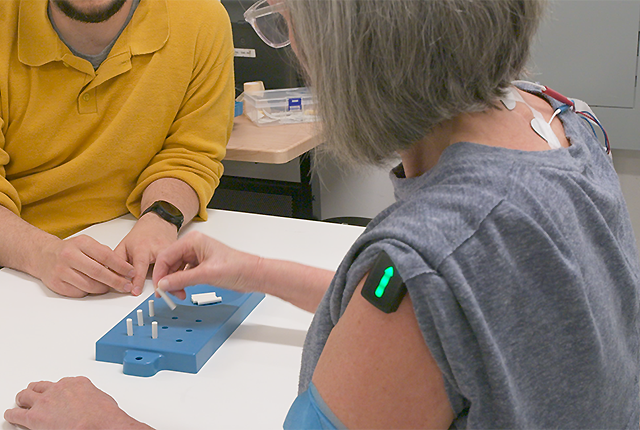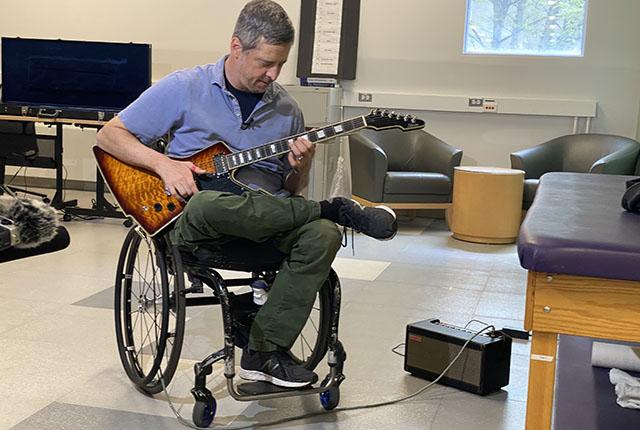
Device restores hand function for some with spinal injury
In a study, people with paralysis saw arm strength and function improve via electrical stimulation to the injured area.Media Contact: Chris Talbott - 206-543-7129, talbottc@uw.edu
After half a decade of tirelessly working to reverse the effects of a 2005 spinal-cord injury, Jon Schlueter remembers finally lowering his expectations.
Schlueter had dedicated himself to an exercise-based rehabilitation after a shallow-diving accident left him with an incomplete C5-C7 spine injury. He needed to make the most of the limited window those with spinal-cord injuries have to regain significant function. But his gains had leveled off. He acknowledged to himself it was time to move on from the idea he might have more than limited use of his arms and hands.
“Conventional wisdom with a spinal cord injury then was you had up till five years for the spinal cord swelling to go away and for any returns to come,” Schlueter said. “I spent those first five, seven years really doing nothing else but rehabilitation just five days a week at the UW and private facilities, then doing it at home by myself, becoming obsessed. But the gains leveled off. I’d all but forgotten about the right side of my body.”
Fifteen years later, Schlueter has a renewed outlook on recovery after participating in a University of Washington School of Medicine study of an electrical-stimulation device that shows great promise for patients with loss of function and other side effects of spinal cord injury. The 49-year-old Seattle resident now plays the guitar for hours each week and continues to improve. He’s regained use of his right hand and arm, has newly regulated blood pressure and other systemic issues and is excited about the prospects for continued recovery.
The international clinical trial used a device that provides electrical current to the spinal cord through electrodes on the skin. The patches are designed to numb the contact point to allow for five times more current to be delivered compared to standard treatments.
A study published May 20 in Nature Medicine describes the gains Schlueter and others experienced in the trial of more than 60 patients with tetraplegia, a loss of some or all function in all four limbs. A research team led by Chet Moritz, professor of rehabilitation medicine at the University of Washington School of Medicine, found that 72% of participants significantly improved strength and function by using the treatment for two months.
Further, the participants in the initial studies kept those gains even after discontinuing use of the electrical-impulse device.
“We've seen people that have no functional use of their hands at all go from not being able to pick up an object or manipulate an object all the way to being able to play an electric guitar or use a paint brush on canvas,” said Moritz, who is also a UW professor of electrical and computer engineering.
“We've also seen some people who had no movement of their fingers at all start moving them for the first time in more than a year since their injury.”
Twenty-eight percent of study participants did not meet the criteria that signaled improvement, possibly due to the severity of their injuries.
The range of outcomes reflects the uniqueness of each spinal cord injury. Most often the spine is crushed or bruised, Moritz said, but not severed completely. Some study participants like Schlueter have seen powerful results, but his gains are still uneven. He can play most chords with his left hand pressing the strings to the fretboard confidently up and down the guitar neck. He has more limited use of his right hand, using a thumb pick to strike individual notes and strum the strings.
“We used to essentially give up significant recovery after about a year post-injury,” Moritz said. “The chances of recovering were in the single-digit percentages, 2% to 8%. The fact that we're seeing 72% of people recover, all more than a year after their injury — and even 10, 15, up to 35 years after their injury — is extremely exciting.”

Onward Medical, the maker of the ARC EX device, has applied to the U.S. Food and Drug Administration for approval to take it to market. The clinical use of the machine, invented at UCLA, was refined by Moritz and colleagues through multiple collaborative studies. The device is a small, nondescript black box that nevertheless delivers big results.
Participants at Moritz’s lab began the study by spending two months going through rehabilitation exercises without the device. These tasks included picking up ping pong balls and putting them into containers, then moving to progressively smaller items down to tiny beads. They also pulled toothpicks out of a container of stiff putty and reinserted them into a different container. And they stacked small blocks to build towers.
While the exercises may sound simple, each takes extreme patience and concentration for people who have lost function from spinal cord injury.
Study participants had the electrodes applied over the injured area of their spine. A therapist worked with each participant to correct technique while a technician recorded results. Participants can be seen gaining proficiency over the course of a single use of the device. The electrical current primes the user’s nervous system, though it does not directly cause the muscles to move, Moritz said. The user is choosing when and how much to move.

“We tried it for over a week without stimulation and I was just flatlined,” Schlueter said. “Then we put the power on my neck, for lack of a better way to put it, and it was immediate. As soon as they turned it on, I could pick up that little ball. It was really exciting. I mean, everybody in the room was as excited as I was.”
Schlueter and his cohort have seen other benefits as well. People with spine injuries often struggle with low heart rate, blood flow and blood pressure. Researchers saw improvement in those areas, as well. Some even reported improved function in their lower extremities during use of the device. That finding led to several new studies examining leg function and walking.
Schlueter has pushed the bounds of what’s possible, perhaps more than any other study participant, Moritz said.
“Jon definitely received benefit from the stimulation,” he said, “but he also did a lot of hard work on his own. He surprised us that he was able to go home and play his electric guitar after each stimulation session.”
“It has taken hours and hours and hours and hours and hours to be able to fret chords, run scales and play songs,” said Schlueter, who is currently learning the solo from The Eagles’ “Hotel California.” “This guitar has become its own form of therapy.”
Initial work was funded by the National Science Foundation, the Craig H. Neilsen Foundation and Wings for Life. The clinical trial was funded by the company Onward.
The authors’ conflict-of-interest statements are in the published paper, which will be provided to journalists upon request.
Related: Access downloadable, broadcast-ready video interviews with Chet Moritz and study participant Jon Schlueter.
For details about UW Medicine, please visit https://uwmedicine.org/about.
